|
|
|
Great Escapes for Father’s
Day Going Wild in Wine Country
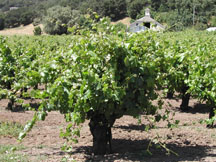 By
Mary Swift-Swan By
Mary Swift-Swan
At the north edge of San Francisco Bay are
miles of wine country. To the northeast lies Napa, and to
the northwest lies Sonoma County. Sonoma County includes
towns with the names of known wines like Glen Ellen,
Kenwood, Windsor, and more. The county is filled with many
outstanding wineries and scenic wonders. There so many
things in Sonoma County it takes more than one day to see
even a part of it. Finding a place to stay can make the
visit a wonderful retreat. Check www.sonomacounty.com or
707-865-0565 if planning a visit. But there is one place
some may miss. Located less than an hour north of Larkspur,
on the north side of Santa Rosa ,is a place that is wild.
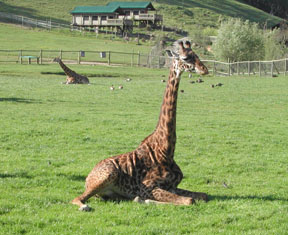 Safari
West would be a great adventure for Father’s Day, or any day
of the year. Safari West is a wild get-a-way for a few hours
or several days. Some schools have already found Safari West
to be an amazing place to open minds and thrill kids. Two
months a year, mid-April to mid-June, M-F, 9-noon, the place
echoes with the laughter of children. When the buses leave,
the only calls are from cranes and creatures native to the
wilds of Africa. Safari tours run three times daily, and can
take up to 300 people. Safari
West would be a great adventure for Father’s Day, or any day
of the year. Safari West is a wild get-a-way for a few hours
or several days. Some schools have already found Safari West
to be an amazing place to open minds and thrill kids. Two
months a year, mid-April to mid-June, M-F, 9-noon, the place
echoes with the laughter of children. When the buses leave,
the only calls are from cranes and creatures native to the
wilds of Africa. Safari tours run three times daily, and can
take up to 300 people.
Owned by Peter and Nancy Lang, Safari West
is a wildlife preserve which has been a frequent site for
television features by Bay Area Backroads and Animal Planet.
It has been the setting for exotic weddings, unforgettable
business conventions, and a place to break away for a wild
moment while on winetasting excursions. The 400 lake-studded
acres are home to 400 mostly African animals. It has been
said by some who have lived in Africa that, “Safari West is
the closest thing to traveling to Africa itself.”
It is possible to stay long enough to
really soak in the essence of being in Africa. Four years
ago, the best safari tent maker in all of Africa made 32
authentic safari tents so visitors can experience a real
African safari. The tents make camping an elegant
experience. They have pillow-top beds, heaters, handmade
doors, furnishings, and hardwood floors. The tents overlook
the giraffe pastures. There are also a few cottages
available. Corporate America has begun to discover that up
to 90 people can be accommodated for one or more nights. The
banquet and conference tents have Internet access. There is
a large screen where African movie nights occur. The meeting
rooms easily accommodate between 80 to 100 people. Larger
groups can overflow to a cooperative neighboring facility.
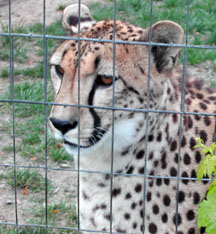 Nancy
was the curator responsible for the birds at the San
Francisco Zoo for many years before joining Safari West.
Nancy has helped establish a respected walk-through aviary,
while more aggressive birds are in cages on the property.
She and Peter married in the early 1990s. Nancy is the
driving force behind creating the education programs; a
public, friendly dining room; conference area; store; and
accommodations, and opening the initially private Safari
West to schools, corporate groups, and the public. A pair of
Cheetahs live in a large run next to the main complex of
buildings. There is another small cat, a few primates, and
the aviary, but most of the animals are hoof stock. The
property was originally a cattle ranch. When purchased in
1989, it was set up with three houses, barns, corrals, and
cross fencing. Animals not yet adapted to the current
weather, those being picked on by other animals, or those in
for a checkup, live in and around the barns and corrals near
the entrance. Most of the African animals live in pastures,
roaming a habitat that is much like their native Africa. The
property is a mix of grassy pastures, rolling hills with
oaks, and scrubby trees supported by water from three lakes
and four wells. Nancy
was the curator responsible for the birds at the San
Francisco Zoo for many years before joining Safari West.
Nancy has helped establish a respected walk-through aviary,
while more aggressive birds are in cages on the property.
She and Peter married in the early 1990s. Nancy is the
driving force behind creating the education programs; a
public, friendly dining room; conference area; store; and
accommodations, and opening the initially private Safari
West to schools, corporate groups, and the public. A pair of
Cheetahs live in a large run next to the main complex of
buildings. There is another small cat, a few primates, and
the aviary, but most of the animals are hoof stock. The
property was originally a cattle ranch. When purchased in
1989, it was set up with three houses, barns, corrals, and
cross fencing. Animals not yet adapted to the current
weather, those being picked on by other animals, or those in
for a checkup, live in and around the barns and corrals near
the entrance. Most of the African animals live in pastures,
roaming a habitat that is much like their native Africa. The
property is a mix of grassy pastures, rolling hills with
oaks, and scrubby trees supported by water from three lakes
and four wells.
 To
see the many intriguing hoof animals, there are 14 miles of
wooded trails and picnic grounds but most guests travel by
safari jeeps with a driver who is a well-informed naturalist
narrating the who’s who among the resident animals on the
property. Our group was amazed and entertained by John
Roberts, who joined Peter shortly after he moved to the area
with 250 critters. John drove through the property showing
us the many different kinds of animals. At the back fence,
we located the herd of Watusi cows with their amazingly
large horns roaming the back section. The biggest tenders of
Watusi cattle are the Masai. The Masai tribes estimate the
worth of a person by the number and health of their cattle.
Safari West would be considered very rich and respected due
to the number of well-fed and cared-for cows. John told us
these cows are tough to eat, do not produce a lot of milk,
or cross breed well, but they are characters,
nondestructive, have lots of babies, and live for about 24
years. To
see the many intriguing hoof animals, there are 14 miles of
wooded trails and picnic grounds but most guests travel by
safari jeeps with a driver who is a well-informed naturalist
narrating the who’s who among the resident animals on the
property. Our group was amazed and entertained by John
Roberts, who joined Peter shortly after he moved to the area
with 250 critters. John drove through the property showing
us the many different kinds of animals. At the back fence,
we located the herd of Watusi cows with their amazingly
large horns roaming the back section. The biggest tenders of
Watusi cattle are the Masai. The Masai tribes estimate the
worth of a person by the number and health of their cattle.
Safari West would be considered very rich and respected due
to the number of well-fed and cared-for cows. John told us
these cows are tough to eat, do not produce a lot of milk,
or cross breed well, but they are characters,
nondestructive, have lots of babies, and live for about 24
years.
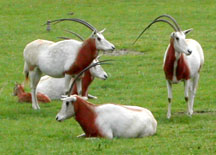 It
was interesting to learn of the many types of antelope.
Nearly two thirds of the breeds have horns, male and female.
In a group where females can defend themselves, they have a
very loose family structure. The other third of the antelope
species, where only the males have horns, there is a very
tight family arrangement. Another interesting fact is that
horns vs. antlers are a key difference between an antelope
and deer. Horn is alive and does not fall off nor can it be
replaced if broken. Antlers grow in a single season and fall
in fall. The endangered Scimitar Horned Oryx were originally
from the Sahara desert region; these unique horse-like
animals have become extinct in the wild. It
was interesting to learn of the many types of antelope.
Nearly two thirds of the breeds have horns, male and female.
In a group where females can defend themselves, they have a
very loose family structure. The other third of the antelope
species, where only the males have horns, there is a very
tight family arrangement. Another interesting fact is that
horns vs. antlers are a key difference between an antelope
and deer. Horn is alive and does not fall off nor can it be
replaced if broken. Antlers grow in a single season and fall
in fall. The endangered Scimitar Horned Oryx were originally
from the Sahara desert region; these unique horse-like
animals have become extinct in the wild.
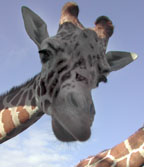 April
through fall male giraffes are let out into a 12-acre
pasture near the main buildings where they often greet
visitors as they pass through on Safari jeeps or the longer
Safari Queen. Safari West currently hosts 8,500 school kids
during the week in a variety of learning programs. The very
curious male giraffes will stick their noses right up to
kids on tour. Giraffes like to be gently fed, but not
petted. A bit of grass or grain in hand can is a way to make
friends. They have an 18” long black tongue used to get food
hard to reach. Their muzzle is soft and whiskery, so hold
offered food out with an open hand. April
through fall male giraffes are let out into a 12-acre
pasture near the main buildings where they often greet
visitors as they pass through on Safari jeeps or the longer
Safari Queen. Safari West currently hosts 8,500 school kids
during the week in a variety of learning programs. The very
curious male giraffes will stick their noses right up to
kids on tour. Giraffes like to be gently fed, but not
petted. A bit of grass or grain in hand can is a way to make
friends. They have an 18” long black tongue used to get food
hard to reach. Their muzzle is soft and whiskery, so hold
offered food out with an open hand.
Safari West is a member of the American
Zoological Association,(AZA), of which 190 out of the 200
members are zoos. Members of the AZA buy, sell, trade, and
breed wild animals. Only a few birds came directly from
Africa. The rest of Safari West’s collection were born and
raised onsite or by members of the AZA, although they
originated from Africa. One of the benefits of this fine
facility is that it is having noted success breeding in the
natural African-like climate and terrain. Safari West is
active in the joint AZA effort to preserve endangered
breeds, working with other AZA members to collectively raise
enough of those extinct in the wild through breeding
programs.
 In
the second sector of 100 acres, just out from the main
complex pastures, is a mixed group of animals, wildbeasts, a
variety of antelope, gazelles, and Cape Buffalo. The most
dangerous animals on the property are not the Cheetahs. They
are the Cape Buffalo. In Africa, the Cape Buffalo are listed
as one of the five most dangerous animals along with the
lion, leopard, elephant, and rhino. They are big and stocky
and not to be messed with. Their horns cover the entire top
of their skull, making a very effective battering ram. Only
32 Cape Buffalo are in captivity among the 200 members of
the AZA in the U.S. and Canada. Of those, five live at
Safari West. One is just a year old, born onsite last year
with, by chance, Animal Planet on hand to film the whole
event for television. This is a great place to visit often
for naturalists and photographers. In
the second sector of 100 acres, just out from the main
complex pastures, is a mixed group of animals, wildbeasts, a
variety of antelope, gazelles, and Cape Buffalo. The most
dangerous animals on the property are not the Cheetahs. They
are the Cape Buffalo. In Africa, the Cape Buffalo are listed
as one of the five most dangerous animals along with the
lion, leopard, elephant, and rhino. They are big and stocky
and not to be messed with. Their horns cover the entire top
of their skull, making a very effective battering ram. Only
32 Cape Buffalo are in captivity among the 200 members of
the AZA in the U.S. and Canada. Of those, five live at
Safari West. One is just a year old, born onsite last year
with, by chance, Animal Planet on hand to film the whole
event for television. This is a great place to visit often
for naturalists and photographers.
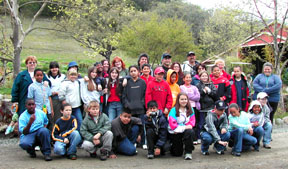 Touring
the property is fun and the entire experience is as genuine
and gracious as the owners and people who work there. It is
clear kids and education are a priority for Nancy. It was a
distinct pleasure to interview Nancy and Peter during the
hors d’oeuvres and wine hour before the delicious buffet
dinner, an option for guests. Touring
the property is fun and the entire experience is as genuine
and gracious as the owners and people who work there. It is
clear kids and education are a priority for Nancy. It was a
distinct pleasure to interview Nancy and Peter during the
hors d’oeuvres and wine hour before the delicious buffet
dinner, an option for guests.
BC: Tell our readers about Safari West’s education
opportunities.
Nancy: We have programs for kindergarten through 6th grade
where groups go on a driving tour with a trained naturalist.
They learn about conservation, animal natural history, the
natural habitat these animals live in (and their),
camouflage, all the aspects of the African collection that
we have here. In addition to that, we have internship
programs for 14 year olds that are three-day certificate
programs. Certificates show that an intern completed a
certain amount work with the animals at the facility. There
are also internships for high school and college students.
High school students in their junior and senior years do
their high
 school
projects here, which is a six-month commitment. And then we
have internships for college students that last six months
to two years. One of our students is starting a master’s
degree program here. We have veterinary interns who have
used their internships to help them gain acceptance to
veterinary colleges. Programs are very in-depth for animal
husbandry, veterinary medicine, and behavioral research. We
are teaching Zoo Biology at Santa Rosa Junior College. That
should become a degree program in a few years’ time. That is
what we are doing now in education. To see the kids come
here during the weekdays is quite special. The
kindergartners are so much fun. There is now a nonprofit
lead by John Menth, who works to get grants to bring out
elderly people, and to help school districts that can’t
afford it to bring out their children to the facility. He
also finds funding to bring out teachers for two-day
educational conferences. John is an educator himself and
very informative on how people can help. school
projects here, which is a six-month commitment. And then we
have internships for college students that last six months
to two years. One of our students is starting a master’s
degree program here. We have veterinary interns who have
used their internships to help them gain acceptance to
veterinary colleges. Programs are very in-depth for animal
husbandry, veterinary medicine, and behavioral research. We
are teaching Zoo Biology at Santa Rosa Junior College. That
should become a degree program in a few years’ time. That is
what we are doing now in education. To see the kids come
here during the weekdays is quite special. The
kindergartners are so much fun. There is now a nonprofit
lead by John Menth, who works to get grants to bring out
elderly people, and to help school districts that can’t
afford it to bring out their children to the facility. He
also finds funding to bring out teachers for two-day
educational conferences. John is an educator himself and
very informative on how people can help.
Peter is the son of Otto Lang, a movie and television
producer and director. Peter may not have shared his
father’s love for the movie industry, but they both loved
Africa. Peter has always loved animals. He started a
longhorn cattle ranch near Los Angeles in 1971. To reduce
the scrub brush and poison oak, a friend who ran the Fresno
Zoo suggested Eland antelope. They ate the poison oak like
candy and cut way down on the brush. Peter loved it, and the
unique antelope. He tried a few more exotics. Over a period
of ten years, Peter switched to all exotics. When he reached
250 animals, including a few birds, he needed a bigger
spread with water. In Los Angeles, that was hard to find or
afford so he came north to the Bay Area in 1989. The ranch
he eventually purchased was all set up, so it allowed him to
simply move in with all of his animals and continue to grow.
John joined his efforts that same year. Nancy came by the
next year to help with the small population of birds. The
rest is history.
BC: What really got the ball rolling for you? Going from
longhorn cattle to zebras is a bit of a shift.
Peter: Depends on who’s doing it. It seemed pretty
straightforward at the time.
BC: I heard you still move animals for zoos.
Peter: John and I are two of the half dozen or so people who
transport giraffes and other animals for zoos in the AZA. We
don’t do it for a living, but we sort of do it for, well,
you can’t call it a vacation. Driving a big truck with a
30-foot trailer holding a couple of giraffes and other
stuff. But we enjoy it. We go on two round the country
drives annually moving animals. They are fun because these
trips are primarily when there is a lot of exchange of
animals and it allows time to visit and see what is new with
the various zoos and other AZA members.
BC: With the impressive new degree program under
development, what are your next aspirations for Safari West
and yourself?
Peter: The education side is all Nancy. I’ve done enough in
my life. I’m happy getting up each morning. I have a few
things left in my soul. Art. I like painting. I like
sculpture. I haven’t painted for a couple of years because
I’ve been so busy. I want to get back to that.
BC: Do you paint the animals?
Peter: I do that. I can do most anything. I like metal and
wood sculpture.
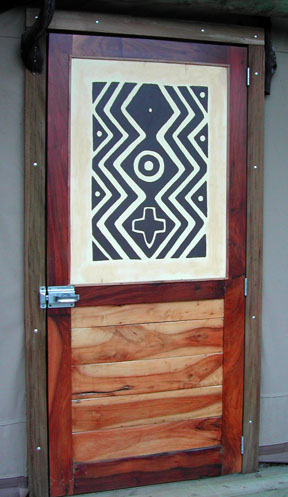 BC:
The wood furniture and functional pieces all over the area
are fabulous. BC:
The wood furniture and functional pieces all over the area
are fabulous.
Peter: We have fun doing that here. People would like to buy
what we make but we do not make things on consignment. We
are tripling the size of the gift shop. Part of that is
going to be for me, to make stuff and to fill people’s
wishes instead of saying, “Ah, I’ll talk to you later.” It
will be nice to be able say, “Go up and take a look, and if
you like it, it’s yours.” I can’t say I’ll make a table just
like another. I can’t get the next piece of wood just like
the last one. That is why I can’t do things on commission.
John tells our tales better than I. He makes them fun and
spicy.
John, our guide responsible for so much of the information
in this article and Peter’s right hand in running Safari
West, informed our tour group that wood for tables, doors,
lamps, vanities, dressers, and everything at Safari West,
except the chairs, were handcrafted by Peter. He had help
from John and a few staff members. Wood is gathered from
local road crews saving the county disposal costs. Peter and
John go out with a truck and trailer and collect the wood.
Sometimes wood is brought in by neighbors clearing fallen
trees or excess growth. All trees that fall on Safari West
property are left to add to the habitat, unless it is
blocking a roadway. On our safari’s return to the complex,
John pointed out a large pile of rough chunks of wood
drying. It was amazing to think that from that humble pile
of wood came all the wood fixtures and furniture.
BC: John said Safari West is helping to keep species
alive. Please elaborate.
Nancy: We have species that are extinct in the wild. We have
the Addax and Scimitar Horned Oryx. There are some new
programs going on where they will be released into the wild
and down the road we will participate in those. In the
meantime, we focus on education about species that are
endangered or extinct because of habitat encroachment, human
activity, and in some cases, a combination of both. We are
working to make people, especially young people, aware of
what they can do.
I’d like to tell a story about what one
person can do. A friend of mine named Graham worked at the
San Francisco Zoo. He started out as part-time veterinarian.
He volunteered in Madagascar part of the year, working with
the lemurs and learning why they were becoming extinct in
the wild. He ended up setting up a program, in conjunction
with other people and the Madagascar government. They are
breeding lemurs in captive situations like our lemurs. They
reintroduced them into Madagascar in breeding groups. Now
young pairs being released in the wild are again breeding.
That story is an example of what one
person can do. So many times kids are told there is nothing
left. Everything has been destroyed. There is no hope. But
there are so many good things and so much can be done. It is
important that young people understand they can make a
difference.
Madagascar lemurs had become nearly extinct, as their rain
forest habitat was being clear-cut to create arable land for
the world’s consumers increased demand for Madagascar
vanilla. Vanilla bean farmers expanded due to economic need
to survive. Cutting rain forests down and driving lemurs to
the edge of extinction was not based on needless greed but a
matter of economics for family subsistence. People in our
country do not understand the simple facts of survival in
third world countries and choices they have to make. The
benefit in the situation of the competing industries of
vanilla and tourism is that visitors to the rain forests to
see lemurs give an option for income as tour guides.
 In
Zimbabwe, hunting many animals was banned. Native
populations continued to lead hunters into the wild as a
form of income, poaching. The government tried fines and
picking them up but it did not stopping hunting. To change
the situation, the government set up a number of preserves
for hunting with safe limits. The most local village to each
preserve manage it, taking in hunters for specified limits.
It provides an ongoing income so those once poachers are now
conservationists. They will now take out anyone who tries to
poach their wild animals on their preserves. The limits set
for hunters do not endanger any species. It has been a
wildly successful program. Money earned goes to the local
people. They set up councils and decided what to do with it.
They’ve built schools and a grainery, etc., whatever was
needed by each community to survive and grow. In
Zimbabwe, hunting many animals was banned. Native
populations continued to lead hunters into the wild as a
form of income, poaching. The government tried fines and
picking them up but it did not stopping hunting. To change
the situation, the government set up a number of preserves
for hunting with safe limits. The most local village to each
preserve manage it, taking in hunters for specified limits.
It provides an ongoing income so those once poachers are now
conservationists. They will now take out anyone who tries to
poach their wild animals on their preserves. The limits set
for hunters do not endanger any species. It has been a
wildly successful program. Money earned goes to the local
people. They set up councils and decided what to do with it.
They’ve built schools and a grainery, etc., whatever was
needed by each community to survive and grow.
Safari West is also wildly successful and continues to grow.
On July 3rd, there will be a Red White and Blues concert and
on the 4th of July at Safari West the public is invited to
celebrate the birth of a nation and the many recent births
at Safari West. The fee is $60 for adults to enjoy a BBQ and
hour tour on the African Queen party wagon. Kids are less.
There is a great lineup of adorable babies. In the past
several months, a baby ring-tailed lemur, ruffed-tailed
lemur, two giraffes, an African-crested porcupine, aoudad
sheep, watusi cattle, and several species of antelope,
including gemsbok, waterbuck, and springbok plus two
adorable baby bongos, have been born and can be seen by
visitors.
 Safari
West does not advertise. Those who find them do so from
articles in publications such as Bay Crossings, television
features, and the Internet. In this quiet way, and by
word-of-mouth, they annually host 35,000 people. They are
looking into more safari jeeps and tent cabins. Most who
have been there go back and bring friends, coworkers, and
family. Nancy mentioned that a few of their friends who have
lived in Africa come to stay a few nights when they get
homesick. When you’re ready to try something really
different, take the River Road exit off Highway 101 north.
The approach to the exit is also marked Calistoga/Mark West
Springs Rd. Exit the freeway and turn RIGHT. You will be on
Mark West Springs Road heading East toward Calistoga. Remain
on this road for 7 miles. At Franz Valley Road, turn LEFT
directly into the entrance. For more directions,
information, a virtual tour, or reservations, call (707)
575-2551, (800) 616-2695, or
www.safariwest.com. Safari
West does not advertise. Those who find them do so from
articles in publications such as Bay Crossings, television
features, and the Internet. In this quiet way, and by
word-of-mouth, they annually host 35,000 people. They are
looking into more safari jeeps and tent cabins. Most who
have been there go back and bring friends, coworkers, and
family. Nancy mentioned that a few of their friends who have
lived in Africa come to stay a few nights when they get
homesick. When you’re ready to try something really
different, take the River Road exit off Highway 101 north.
The approach to the exit is also marked Calistoga/Mark West
Springs Rd. Exit the freeway and turn RIGHT. You will be on
Mark West Springs Road heading East toward Calistoga. Remain
on this road for 7 miles. At Franz Valley Road, turn LEFT
directly into the entrance. For more directions,
information, a virtual tour, or reservations, call (707)
575-2551, (800) 616-2695, or
www.safariwest.com.
TOP
Grads and Dads
 By
Mary Swift-Swan By
Mary Swift-Swan
Set in the hills facing San Francisco, in
the sister city of Berkeley, stands the castle-like
Claremont Spa & Resort that has pampered guests for over 80
years. The Claremont is the perfect place to return to after
a full day of enjoying the area. Once settled in, the
temptation to simply enjoy the many luxurious and rich
opportunities this castle-like resort offers is striking.
Thirty-five to forty years ago, the
Claremont’s carpets showed wear and tear and the grounds
needed an update. The property did not disguise the outlines
of its former grandness or its antiquity. On weekends, the
ballroom was a youth dance hall with “go-go” girls dancing
near two stages where bands played for hundreds of high
school kids. It was a fun place for those under drinking
age. In that era, before drugs and youth gangs, those kinds
of venues were possible. Due to the ever kind, professional,
and security-conscious staff, parents did not have to worry
if their kids were at the Claremont. Kids were respectful of
the Claremont as an active elegant hotel, although it was
also the place high school graduates went for a right of
passage.
High school grads were dared to sneak, in
very small groups so as not to alarm staff or disturb hotel
guests, to upper floors to find the laundry shoot. Kids that
were slim and fit were the only ones who could do it. No
Levis or clothes with bits of metal, even shoes and belts
were removed to avoid making noise by scraping or banging
the metal sides of the circular shoot. Down several stories
in the dark, circular laundry shoot they would fly, holding
their mouths to suppress the screams of fear and delight so
as not to be heard by guests or management. The end of the
ride was always uncertain; was the door locked, was there a
basket on rollers, or just the ground or hotel staff with
police waiting? Each kid had to quickly move out of the way
or there would be a pileup at the back of the hotel. With no
time to loose, in case the staff noticed, kids quickly
dusted themselves off. They reassembled themselves, then
returned to the front of the hotel, where they tried to act
natural as they rejoined the dance or went to their cars.
(Lost a tennis shoe in the shoot. It was hard to act natural
with just one shoe.) They tried not to be obvious, gush
about the moment, or laugh loudly or they’d get caught. Not
getting in trouble and avoiding upsetting the hotel
operators or guests was all part of the thrill and the rite.
Those kids are now grown, many with their
own kids or even grandkids graduating from high schools and
colleges this month. The hotel has renewed itself and is
again a local favorite as a well-loved place for fun. If a
middle-aged baby boomer is noticed with a nostalgic smile,
one might inquire if they grew up nearby. The laundry shoot
is not an option anymore, only a memory. Many of these
former “pranksters” can now afford to stay at The Claremont,
instead of experiencing the hotel by jumping down the
laundry shoot feet first. It is very gratifying for those
who knew it back when to see the hotel returned to its
original grandeur as an elegant resort with sparkling pools
and modern touches like the Spa.
After checking in, you may find upon
entering your room a scrumptious display of strawberries and
cream in a “box” made entirely of chocolate, plus a bottle
of chilled champagne, just waiting for the right moment. If
it’s exercise you’re after, there are two outdoor pools and
tennis courts to enjoy. After exercising or enjoying the
area’s many wonderful sites, indulge in a massage and save
some time to lounge about the pool. Hot tubs, steam rooms,
and saunas are also available at the fine European Spa.
Bathrooms have whirlpool tubs. Luxurious bathrobes hang in
the closet, so warm and embracing that it might almost be
sad to get dressed for dinner. But do it. The dining
experience is worth a trip to the hotel on its own. Jordan’s
Restaurant treats guests to a variety of pleasant music
while enjoying a sumptuous four-course meal at the
Claremont’s signature restaurant. A perfect way to end a day
spent celebrating Father’s Day, graduation, a special
occasion, or anyday of summer, fall, winter, or spring.
Claremont Hotel, 41 Tunnel Road, Berkeley, CA. 510-843-3000,
www.claremontresort.com.
TOP
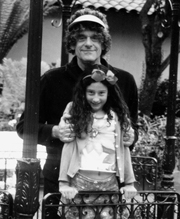 “Glad
U are My Dad” “Glad
U are My Dad”
By Elianna Reuben
I am Elianna, daughter #1 of the famous
photographer, Mark Reuben. I am 10 now.
Together, he and I feed the birds, go to
his boat and play games. We take pictures together, too, and
go sailing. I show him my great gymnastics tricks, watch
movies, go to special places, and more... but what I
absolutely love doing with him is being alone with him,
talking and (him) telling me things to act out and me doing
it. For example, one time he told me to act out me walking
down the street and seeing my long-lost friend, Sabrina, who
is probably in Colorado, and my reaction to that. My brother
Joseph likes to act things out, too. We love it especially
because we love acting and our dream is to be on TV.
Anyways, Mark Reuben has a number of
“perfect” photography galleries featuring sports champions
like Barry Bonds, Babe Ruth, Tiger Woods, and much more. He
also has famous pictures of heroes, like Helen Keller and
Amelia Earhart. His “perfect” galleries also have beautiful
landscapes of California, such as the Golden Gate Bridge,
Mount Shasta, Yosemite, and he also has pictures of
different times in history. For instance, the Gold Rush in
1848. There are pictures of Albert Einstein and Teddy
Roosevelt. Amazing great pictures of famous celebrities,
too, like Shirley Temple, Hilary Duff, and more. My Dad is
an excellent photographer! Sometimes, I help my Dad sign his
photographs. Not signing his name for him, but writing the
theme of the picture. For instance, one time I wrote “The
Gold Rush.” I also help him mat his pictures and do other
things. One time, when I was little, my Mom went to get a
coffee and my Dad had to get something. While they was gone,
I sold a picture (by myself). Just saying this again, My
Dad, Mark Rueben, is a wonderful and great photographer!!
TOP |
|